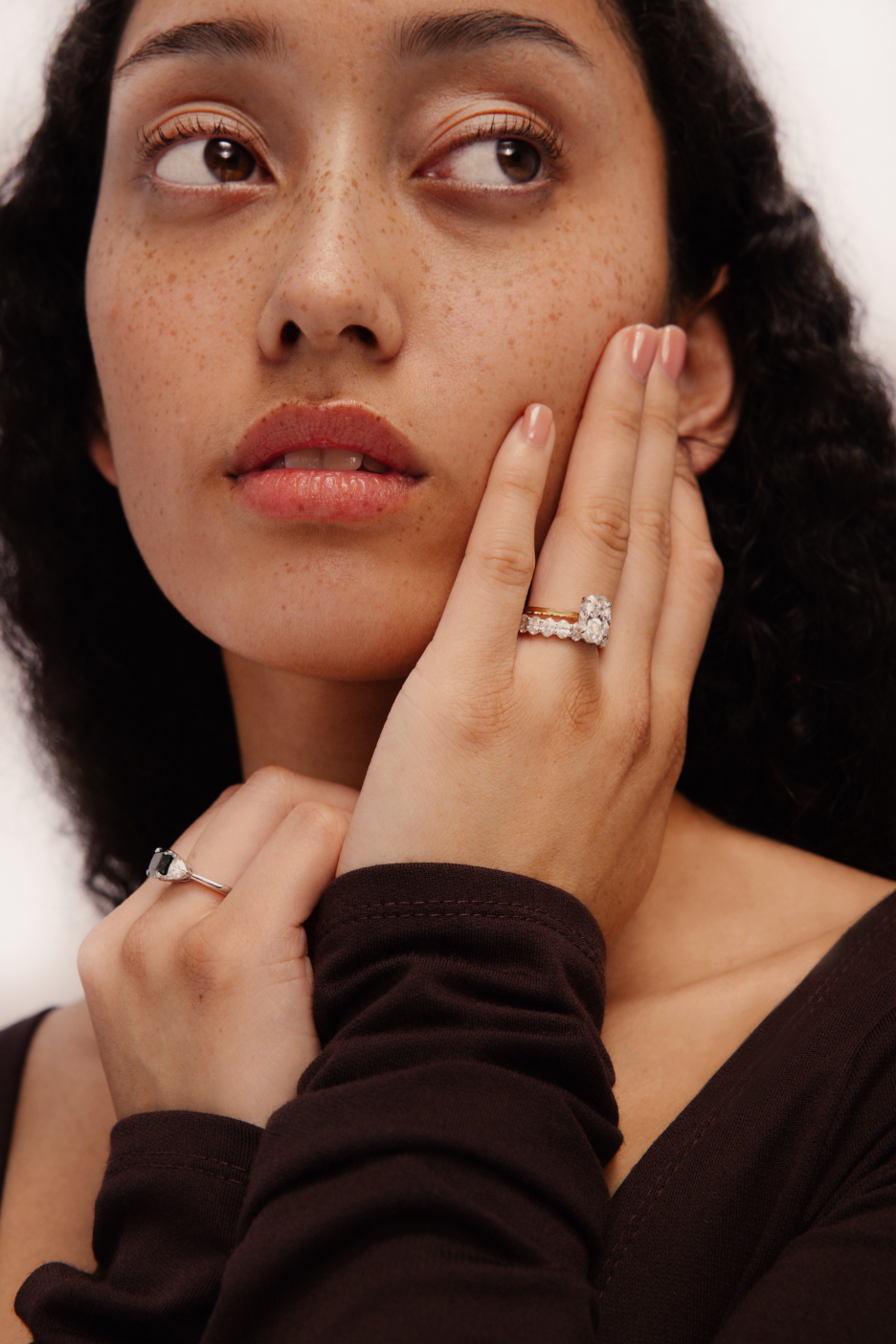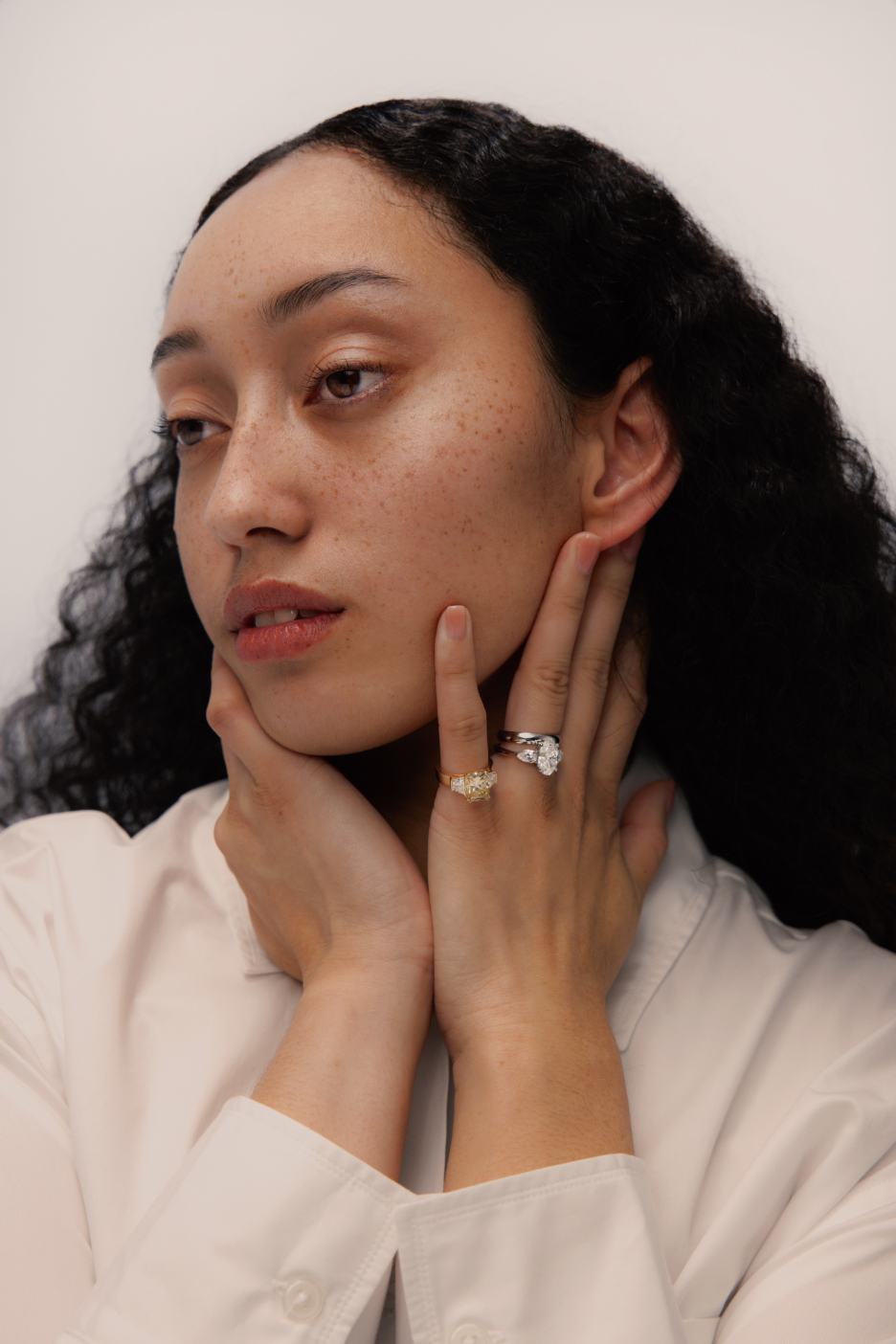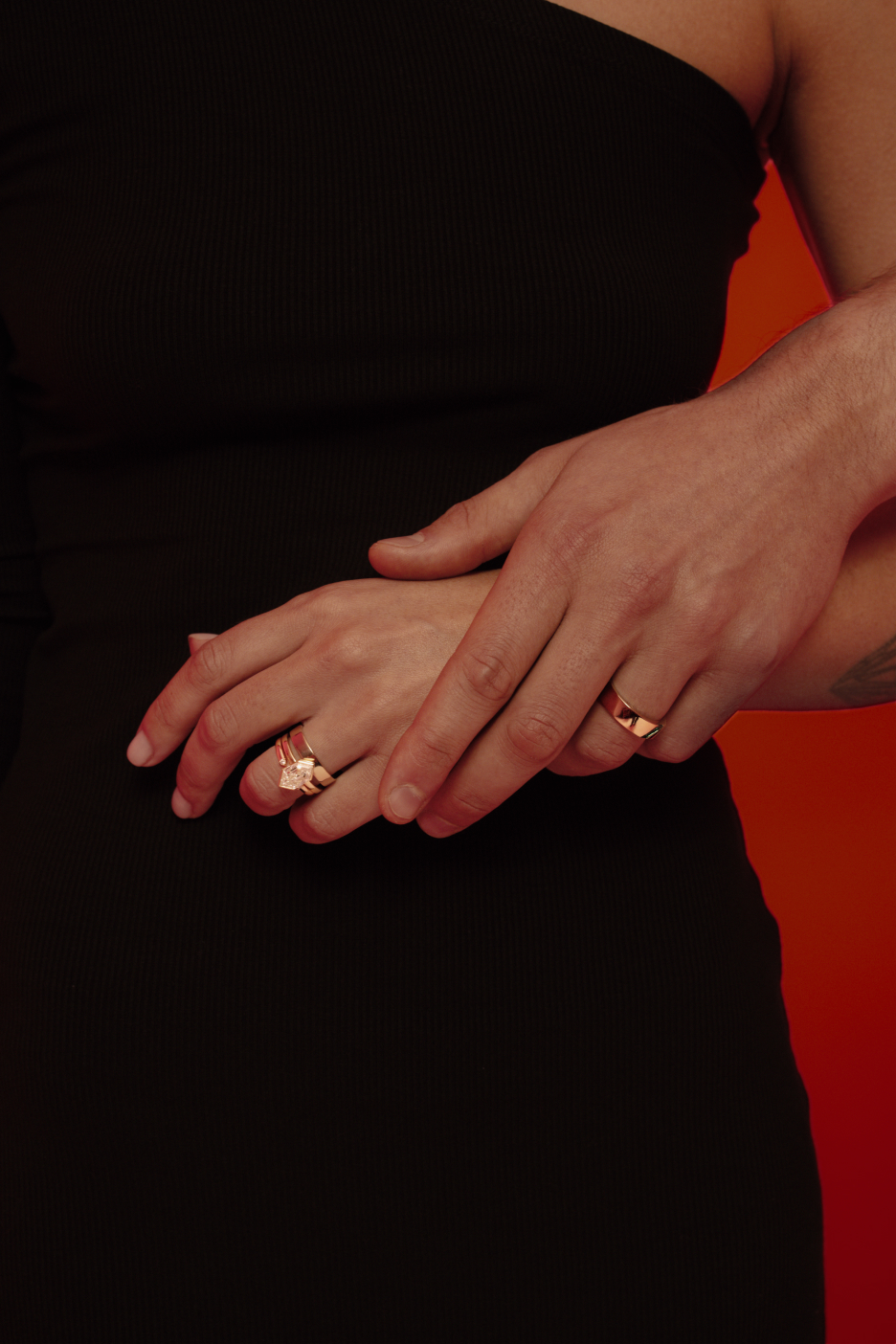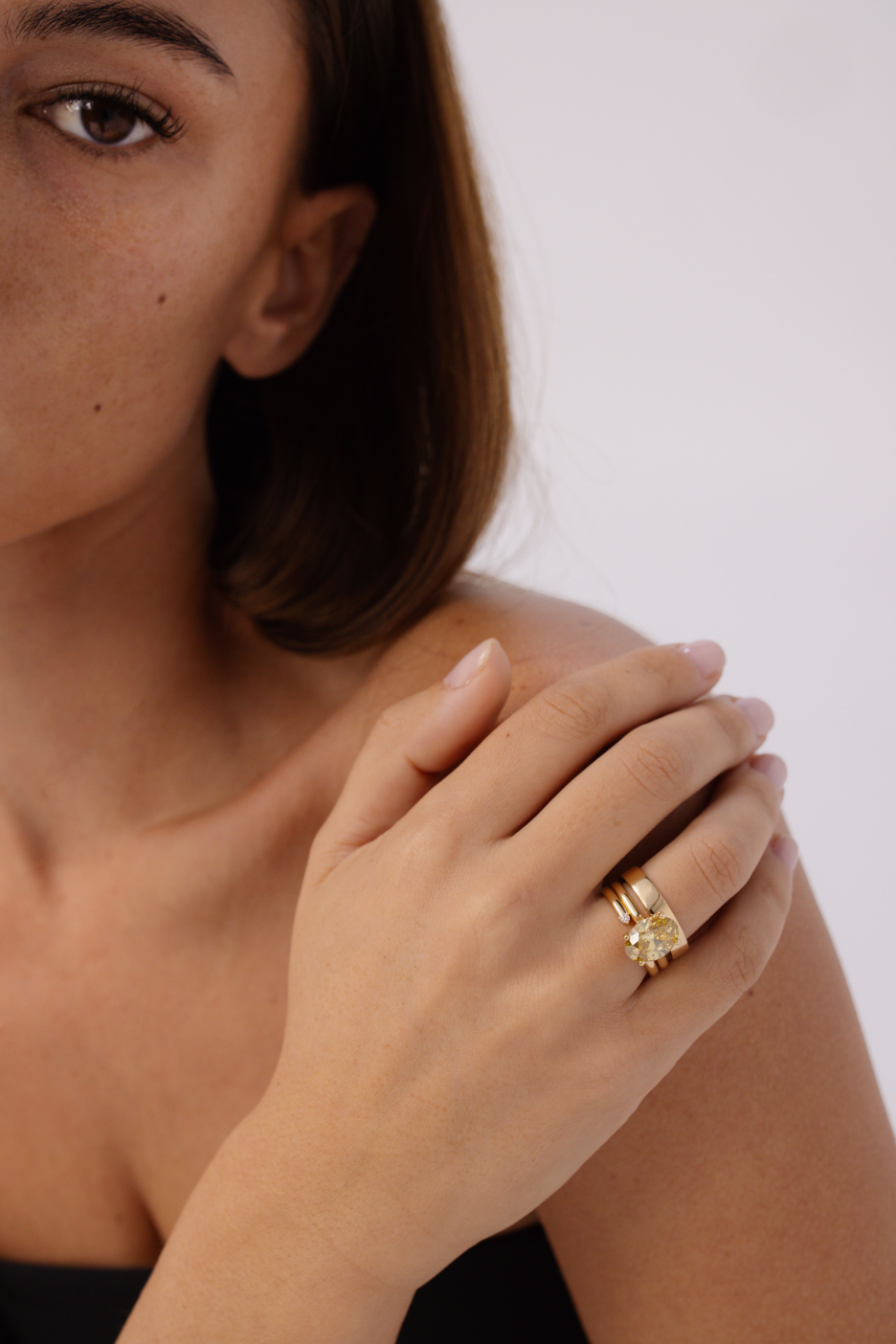Natural diamonds: 6 Reasons To Reconsider

You don’t need to watch ‘Blood Diamond’ to know that “natural” or “mined” diamonds has an overall bad vibe surrounding it. After all, who wants to pay an incredible amount of money for something with a terrible sustainability record, terrible working conditions, and a terrible reputation when it comes to child labour and worker rights. And yes, while a marketing genius came up with the slogan ‘Diamonds are forever’, we didn’t think they intended that to be about the environment or livelihoods. But here we are.
So why choose another gemstone? And what about lab grown diamonds? Everyone has their 2 cents to offer. But we’re here to break it all down — from a jeweller’s perspective.
Natural Diamonds Is 100% Marketing
Coming up with the slogan of the century, Frances Gerety came up with the term ‘A diamond is forever’ in 1947. But before then, diamond engagement rings weren’t as common as they are today. Instead, emeralds, rubies and sapphires actually dominated.
So how did this all change? Well DeBeers had a monopoly of supply on diamond mining, and in the mid 1940s, they had an excess supply — and not enough demand. So as any respectable company would, they hired an ad agency convincing everyone that a diamond ring is the only gemstone that you should propose with — oh and you need to spend 2 months of your salary (now three apparently).

Now here’s the kicker. Natural diamonds aren’t rare whatsoever and DeBeers has a monopoly on supply. They artificially inflate the price for profit.
Diamond’s also aren’t forever. Sure they sit at 10 on the Moh’s scale, but they are not even indestructible. And lab grown diamonds are physically optically and even atomically exactly the same as a natural diamond. They just don’t get the same ‘marketing prowess’. So what do we recommend instead? Do your research. Buy what you love for who you love at a price you’ll love.
Natural Diamonds Are Expensive AF
Speaking about price, natural diamonds are WAY more expensive than the likes of sapphires, moissanites and even lab grown diamonds. And you’ve probably already felt this. Why does a mined 1 carat cost $10,000 and a lab grown diamond cost around $4,500? Well we asked ourselves that too.

DeBeers had a stranglehold on the supply of diamonds so the only thing that they need to gee up is demand. And they did this with clever marketing and leveraging their famous slogan. Chuck in the ‘etiquette’ of spending 2 or 3 months of your salary and there you have it.
But Natural Diamonds Are A Good Investment Right?
Oh man…hate to break it to you. All gemstones, regardless of it being a natural diamond or otherwise depreciate more like cars, and don’t appreciate like stocks or houses. So unless you are buying a museum piece so rare Beyonce is going to show up to the auction, you are never going to get back what you paid for it.
So while yes, you can resell your diamond for it to be sold to someone else, companies gon do what they always done — make profit. So the offer you are going to get is going to be much less than what you bought it at. Got to appreciate the DeBeers hustle, but its straight capitalism baby.
Natural Diamonds Are Bad For The Planet
No matter how much spin the natural diamond industry tries, they will never be sustainable. Because like… how? Mined diamonds are formed deep inside the Earth’s core where high pressure and high temperatures that crystallise carbon atoms into diamonds over millions of years. They are brought to the service through volcanoes and Kimberlite pipes.
These Kimberlite pipes are hundreds, if not thousands of kilometres and finding diamonds in one is a huge mining operation.
To get an idea of the size, the Diamond Council of America estimates that 250 tonnes of earth is moved to produce 1 carat of polished diamond and there are 148 million carats of diamonds mined each year.

Even the richest diamond mine produces 1 part diamond to 40 million parts of waste rock. Some mines are so large that you can see the holes from space.
These mines aren’t created in open wastelands. Diamond miners dig where the diamonds are — whatever people, animals, and ecosystems were there before aren’t thereafter. According to the Leakey Foundation, miners are even threatening world heritage sites around the African continent in search of diamonds.

Furthermore, the reports and sources used in the industry (and referenced in this article) normalise the data on a ‘per carat’ basis. E.g. On average, De Beers mines use 80.3kWH of energy to produce 1 carat of a mined diamond.
However, it is important to remember that carat is just a measure of weight — it does not consider the quality of the diamond and whether the diamond is fully intact. Ten 0.1-carat fragments of brown diamonds are entirely different from fully intact 1 carat weight of gem-quality diamonds.
Argyle mine in Australia produces one-third of the world’s supply of diamonds. It is often used by mined diamond sellers (especially in New Zealand) as an example of ‘clean and ethical diamond mining.’
They repeat that the Argyle mine only uses 7.5kWh of energy per carat of diamond mined, but what is missing is that 80% of the diamonds found in the Argyle mine are brown diamonds — which are near worthless in diamond jewellery. This means the actual energy cost of finding 1 carat of an intact gem-quality diamond is much higher.
According to an independent industry report from Frost & Sullivan, mining operations create approximately 57,000 grams of CO2 per carat of mined diamond. To get a sense of this, the estimated amount of CO2 produced from global diamond mining is equal to 1.5 million cars running for a full year.
So what about lab grown diamonds? Because this process is a closed system inside high-tech laboratories, lab diamonds don’t need large-scale mining operations and the associated negative environmental impacts. Furthermore, lab diamonds are reported to produce 0.028 grams of CO2 per carat created. A far cry from natural diamond’s whopping 57,000 grams of CO2 per carat.

An independent report from Frost & Sullivan comparing the environmental impacts of lab diamonds to mined diamonds found that mined diamonds overall have more than seven times more negative environmental impact than lab diamonds.
And at Four Words, we work closely with Carbon Click to be climate positive. This means for every purchase you make from Four Words, we offset the full supply chain by a factor of five. Buying from Four Words helps plant and maintain trees in the Banks Peninsula in the Canterbury region of New Zealand.
Natural Diamonds Are Shady
You might be wondering if natural diamonds can be ethical. And whether you think it will be via huge operations with explosives, or “artisanal” hands in the dirt type, there are actual people involved in this work. And it fits within a wider social and environmental context.
For example, someone owned the land before the mine was discovered, has to work to source the diamonds, and then care for the land after the mine is depleted. So who gets paid what? And how much?
Call us cynical, but I don’t expect multi-nationals to be paying top dollar for the land to start with, paying top dollar for the extremely dangerous working conditions, or even paying a single dollar to safely close the mine.
But that’s not even all of it. Diamonds themselves can destroy families and even whole countries. Blood diamonds are diamonds that are sold to finance wars and civil unrest. And even while the Kimberley Process was put into place in the year 2000, it’s incredibly flawed to the point that its founders left it because of it being a moral hazard (i.e., the Kimberley process as a front for supposedly clean diamonds when their policies and processes meant that most diamond mines were not even being checked).
Natural Diamonds Are For A Bygone Era
Old money vibes, new money vibes. However and whenever you earned it, natural diamonds just feel gaudy now. Like why would you go out of your way to pay more, contribute to environment destruction and want questionable ethics? Weird flex but ok.
Natural Diamonds Are Gaudy. Consider These Gemstones Instead
Laboratory grown diamonds, moissanites and sapphires are hot right now. You don’t need to spend way more than you need to for something tasteful, classic but unique.
As mentioned, lab grown diamonds are physically, optically and even atomically exactly the same as mined diamonds — but without the environmental and ethical baggage — oh and they are much more affordable.
Moissanites are becoming increasingly popular. They are actually more shiny than diamonds and at 9.5 on the Mohs scale — only behind diamonds. They look very similar to diamonds and most people can’t tell the difference. This gemstone is a great option if you are on a budget.
Want a bit of colour? Lab grown sapphires may be your best bet. Flawless by design, lab grown sapphires come in a range of colours and cuts.

And at Four Words, you can design your engagement ring exactly how you want with our bespoke custom engagement ring design process.
Common Questions
Natural diamond prices have been crashing as lab grown diamonds become more popular. But you wouldn't know that because retailers are still charging around $10,000 per carat for a natural or mined diamond. And once you buy a natural diamond, you can expect to get 20-50% of what you paid for it. So natural diamonds also are not a good investment.






